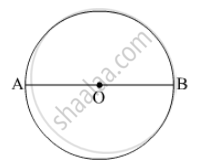Advertisements
Advertisements
प्रश्न
f the coordinates of one end of a diameter of a circle are (2, 3) and the coordinates of its centre are (−2, 5), then the coordinates of the other end of the diameter are
पर्याय
(−6, 7)
(6, −7)
(6, 7)
(−6,−7)
उत्तर

Let O(−2, 5) be the centre of the given circle and A(2, 3) and B(x, y) be the end points of a diameter of the circle.
Then, O is the mid-point of AB.
Using mid-point formula, we have
Hence, the correct answer is option A.
APPEARS IN
संबंधित प्रश्न
(Street Plan): A city has two main roads which cross each other at the centre of the city. These two roads are along the North-South direction and East-West direction.
All the other streets of the city run parallel to these roads and are 200 m apart. There are 5 streets in each direction. Using 1cm = 200 m, draw a model of the city on your notebook. Represent the roads/streets by single lines.
There are many cross- streets in your model. A particular cross-street is made by two streets, one running in the North - South direction and another in the East - West direction. Each cross street is referred to in the following manner : If the 2nd street running in the North - South direction and 5th in the East - West direction meet at some crossing, then we will call this cross-street (2, 5). Using this convention, find:
- how many cross - streets can be referred to as (4, 3).
- how many cross - streets can be referred to as (3, 4).
On which axis do the following points lie?
P(5, 0)
On which axis do the following points lie?
S(0,5)
Prove that (4, 3), (6, 4) (5, 6) and (3, 5) are the angular points of a square.
The midpoint of the line segment joining A (2a, 4) and B (-2, 3b) is C (1, 2a+1). Find the values of a and b.
Find the area of a quadrilateral ABCD whose vertices area A(3, -1), B(9, -5) C(14, 0) and D(9, 19).
Find the area of the triangle formed by joining the midpoints of the sides of the triangle whose vertices are A(2,1) B(4,3) and C(2,5)
If the point P(x, 3) is equidistant from the point A(7, −1) and B(6, 8), then find the value of x and find the distance AP.
Show that ΔABC, where A(–2, 0), B(2, 0), C(0, 2) and ΔPQR where P(–4, 0), Q(4, 0), R(0, 2) are similar triangles.
Find the centroid of the triangle whose vertices is (−2, 3) (2, −1) (4, 0) .
If (x, y) be on the line joining the two points (1, −3) and (−4, 2) , prove that x + y + 2= 0.
Find the value of a for which the area of the triangle formed by the points A(a, 2a), B(−2, 6) and C(3, 1) is 10 square units.
If points (a, 0), (0, b) and (1, 1) are collinear, then \[\frac{1}{a} + \frac{1}{b} =\]
If the centroid of the triangle formed by the points (a, b), (b, c) and (c, a) is at the origin, then a3 + b3 + c3 =
The ratio in which the line segment joining P (x1, y1) and Q (x2, y2) is divided by x-axis is
The ratio in which the line segment joining points A (a1, b1) and B (a2, b2) is divided by y-axis is
If A(4, 9), B(2, 3) and C(6, 5) are the vertices of ∆ABC, then the length of median through C is
Write the equations of the x-axis and y-axis.
Ordinate of all points on the x-axis is ______.
Which of the points P(0, 3), Q(1, 0), R(0, –1), S(–5, 0), T(1, 2) do not lie on the x-axis?
